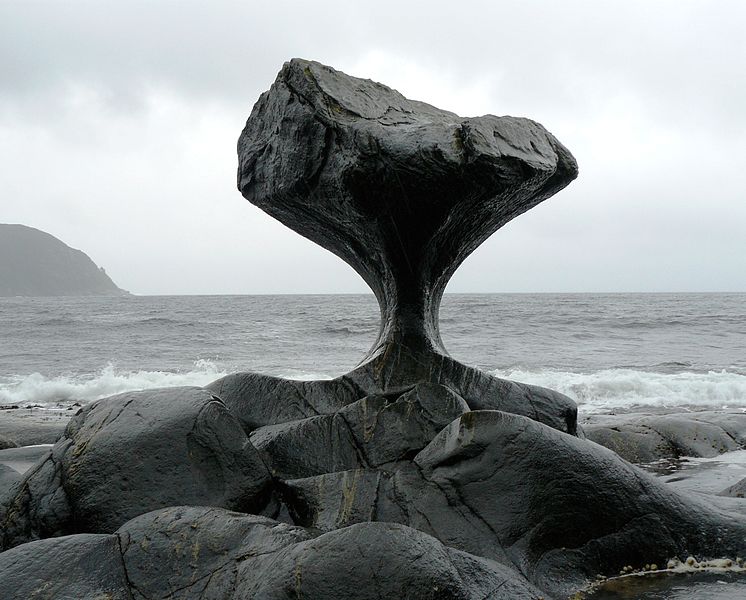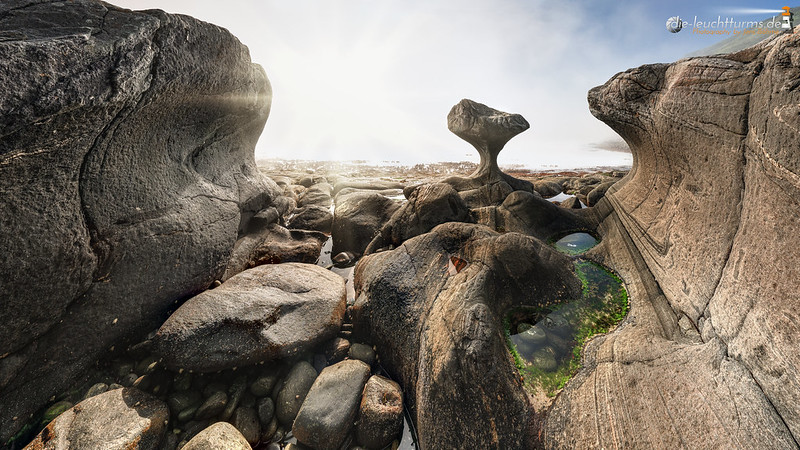The Kannestein rock, a unique rock formation on the island Vagsoy's bay of Kvalheimsvika. The farm of Nord-Oppedal village on Vågsøy island in Norway, about 10 km from Måløy. It is home to the eclogite rocks, which is definitely one the most popular tourist attractions in the area and one of the best known of these is the Kannestein rock on the island of Vågsøy.
 |
| Kannesteinen rock |
Kannesteinen rock formation
Over thousands of years, waves have hammered the Norwegian coast and created many bizarre formations. The most well-known of these is the Kannestein rocks on Vagsoy. It is described as a small goblet with a thin stem. Some people see it as a mushroom. It is known locally as "Kannestolen", or the Kanne chair, and locals don't like that it has been given another name. They felt that the old name made more sense, as the rock looks like a chair on one foot.
Kannesteinen vågsøy rock type — Kvalheimsvika, which is located to the west of Vagsoy's island, faces the open ocean. The bay is exposed the strong westerly winds and heavy breaking waves. These waves can weather some rocks and shape them. This mushroom-shaped rock is known as Eclogite, and Kannestein rocks consist mainly of it. It measures three meters high on the sea-side. It measures 10.4 meters in circumference, while the narrowest portion of the "stem” measures 6.3 meters.
Kannesteinen rock
In many tourist brochures from Vagsoy or Nordfjord, the Kannestein rock is a stunning eye-catcher. It has been the most photographed object within Vagsoy. It is found at the seaside and the sea surrounds it at high tide. It is possible to reach the rock at low tide without getting your feet wet. To get a photo of themselves perched on top of the rock, many people climb up to it. Can also jump from the slippery rock next to the rock, but this isn't for the faint-hearted.
According to Norwegian law, the Kannestein rock is now a protected area. It is required that the rock remains in its natural environment. However, it must be noted that the rock's footing is not very stable. An excavator would be able to lift the rock from its "stem" with a simple push. Others believe that the rock is strong enough that it won't be damaged by natural causes. The rock's future is unknown. Is it better to do something to protect the rock for future generations, or to let nature take its course? Are there any chances of the rock falling into seawater shortly, and then disappearing forever?
First Image / Source
 |
| Kannesteinen |
Image / Source
 |
| Kannesteinen vgsy |
Image / Source
 |
| Vgsy Norway |
Image / Source
 |
| Vgsy |
Image / Source
 |
| Kannesteinen Vågsøy Norway |
Image / Source
 |
| Kannesteinen Vågsøy |
Image / Source
 |
| Kannesteinen Vågsøy Rock type |
Image / Source
 |
| Kannesteinen rock |
Image / Source

 |
| Kannesteinen |
Image / Source
Kannesteinen Rock — Vågsøy, Norway — Google Map
 |
| Kannesteinen vgsy |
Image / Source
Source — Geocaching
No comments:
Post a Comment